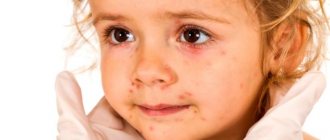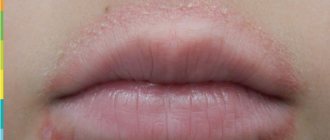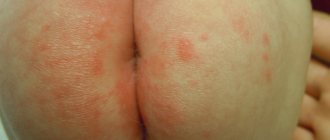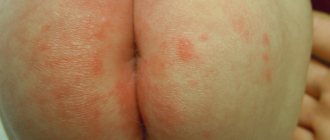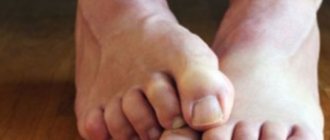A rash is a change in the color and texture of the skin in the form of nodules, blisters, spots, and peeling. The skin of babies and older children is very sensitive to external environmental conditions and general health. Foot rashes in children are caused by allergies, infections, care errors, and autoimmune disorders. It may not bother you or may be accompanied by severe itching and pain. To combat it, it is important for parents and a doctor to find out the cause.
Allergic reactions
Allergic rashes on the feet of a child are caused by various factors. Depending on the type of irritant and the method of contact with it, they appear only in certain areas or throughout the body.
What causes allergies on the feet?
- Medicines. Hypersensitivity reactions are caused by both active and excipients in the drug. Most often it is provoked by antibiotics, sweet syrups, solutions, and lollipops. Within 2–3 hours after taking the product, a red rash, swelling, and itching appear on the child’s body and feet;
- Poisonous plants (poison oak, ivy, sumac). When contacting them on the child’s feet, blisters, a rash in the form of spots or pimples, and swelling form. In this case, you need to thoroughly wash your skin with soap and water and wash your clothes. To prevent future exposure to poisonous plants, teach your children what they look like. When walking, avoid places where they grow;
- Insect bites (bees, wasps, mosquitoes, ticks, fleas). In addition to itching, red rashes on the feet and legs of a child from insect bites, severe reactions are possible - anaphylactic shock and Quincke's edema. These conditions are life-threatening and require emergency care. To prevent bites, stay away from areas where insects congregate. Make sure your child does not run on the grass barefoot or in sandals with bare feet. In the summer, before going outside, apply protective creams or aerosols to exposed areas of your baby’s skin;
- Physical factors. Allergies can be caused by cold, heat, sun rays, pressure, compression. In this case, when freezing or overheating, the child develops a hives-like rash on the palms or soles, which turns pale when pressed. If you notice this reaction, take steps to prevent it from happening in the future;
- Cosmetics for skin care. If a cream or soap contains synthetic fragrances and dyes, then there is always a risk of allergies. Choose products with natural ingredients and no fragrances. Test the effect of a new product on your skin on a small area first.
A tendency to allergic reactions can trigger eczema. This is a chronic disease with a hereditary predisposition. Very often it occurs in childhood. There are several types of eczema. One of them is dyshidrotic. Appears on the palms, soles, sides of the feet, and toes. The elements of the rash look like clusters of fluid-filled blisters up to 5 mm in size, accompanied by itching. After the bubbles open, erosions and crusts form.
If an allergy is detected, you need to be careful with irritants and, if possible, avoid contact with them. As first aid, give your child an age-appropriate antihistamine. Then be sure to contact your doctor to find out what to do next.
The most common causes of rashes on the legs:
- Clothes and shoes. Low-quality synthetic items, residues of powder or other household chemicals on pants, skirts, dresses. Clothes and shoes that are out of season, in which the feet “sore” - all this can lead to an allergic rash on the feet.
- Pet hair.
- Medicines, such as antibiotics.
- Food. The reaction most often occurs to exotic foods, sweets, etc.
- Dust mites living in upholstered furniture, toys, down pillows, thick curtains.
Infections
Infections that cause a rash on a child's feet include diseases caused by viruses, fungi, and parasites. They can affect only the feet or be systemic, spreading to the entire skin. The shape of the rash elements, their number, localization, nature, and speed of appearance are important diagnostic criteria.
Viral infections
With many viral diseases, in addition to a rash on the body and feet, the child has fever, weakness, loss of appetite, sore throat, and runny nose. Moreover, high fever is often the first symptom of infection, which appears several days before the rash. This development is typical for chickenpox, measles, rubella, roseola, and hand-foot-mouth disease (Coxsackie virus), which are easily transmitted by airborne droplets. These conditions resolve on their own; treatment is symptomatic.
The rash is different for each of them:
- Chickenpox. A rash in the form of blisters, which then burst, dry out, and become crusty. Appears first in the chest and back area. Quickly spreads to the face, head, including the scalp, abdomen, arms, legs. Causes severe itching;
- Measles. The rash appears on the third day from top to bottom. First, a brightly colored rash forms on the child’s face, neck, shoulders, then on the torso, arms, legs, and feet. The spots tend to merge with each other. The lower on the body they are, the rarer and less red they are. Pigmentation at the site of the spots lasts up to three weeks;
- Rubella. Pale pink spots appear immediately after the first symptoms and do not merge with each other. First - on the stomach and chest, then quickly spread to the whole body: arms, legs, face, back. And after a few days they disappear without a trace;
- Roseola (sudden exanthema). The rash appears as small, pink, flat spots or slightly raised bumps. Appears on days 3–5. First on the chest, back, then on the arms and legs. There are no other symptoms. The rash lasts up to 4 – 7 days. Roseola mainly affects children under 2 years of age;
- Hand-foot-mouth disease. It is accompanied by ulcers in the mouth, a rash on the palms and soles of the child’s feet, and sometimes on the buttocks. The elements of the rash are painful, but not itchy. They look like flat red spots, sometimes with small bubbles. After 7–10 days they disappear without a trace.
For a photo of what a rash on a child’s feet and body looks like with the listed viral infections, see below:
Scabies
Scabies is an infectious disease caused by a microscopic mite. Infection occurs through clothing, bedding, towels, and washcloths. In children, parasites are transmitted through toys.
The disease is characterized by blisters, a rash elongated in a line, reminiscent of mite burrows (scabies), and itching that intensifies in the evening and at night. Typical places for a rash in a child are on the hands, feet, torso, lateral surfaces of the fingers, and in the spaces between the fingers.
If scabies is detected, the whole family should be treated. The doctor prescribes a special cream that destroys parasites. The product is applied not only to the rash, but also to the entire body, including the face, scalp, and ears. Antihistamine cream or hydrocortisone cream can help relieve itching. For effective treatment, you need to disinfect clothes, towels, and bed linen.
Fungal infection
Fungal skin infections are quite common. At risk, children who go to the pool wear unnatural or too hot shoes, which create a “greenhouse effect.” The elements of the rash are scaly pink spots of a round shape. With a fungal infection, the skin at the site of the infection becomes dry, begins to peel, and becomes covered with microcracks. Sometimes children experience itching and burning. To combat fungal infections, doctors prescribe local antifungal ointments, solutions, and creams.
Unexpected diagnosis: frost allergy
How do people react to cold? Strange question, you say. They shudder, feel cold, may feel goosebumps and even tremble. But for some people, even warm clothes can't save them from red itchy rashes, blisters, and even fever and aching joints! This is what an allergy to cold looks like.
There are no exact statistics on frost allergies. It is known that it appears most often between the ages of 14 and 30, and about 70% of those suffering from it are women. The reaction occurs when the thermometer drops to +4°C and below. In humid air and strong winds, the manifestations are more acute, since the cold is felt more acutely.
I can't tell if the red rash that appears on my skin in winter is a frost allergy or a sign of another problem. Is it possible to determine accurately?
The most affected areas of the body are the nose, earlobes, face, hands. But rashes can also appear under clothing if the person is cold enough. The classic hives appear first—a red rash with swelling, blisters, and itching. Then it may be accompanied by white and pink rashes. If cooling continues, systemic reactions of the body may begin - chills, fever, headache. There is even an increase in temperature and aching in the joints. The most dangerous reaction is Quincke's edema. The eyelids, lips, mucous membranes of the mouth and respiratory tract swell. The throat begins to feel sore and cough, and breathing may be impaired.
Of course, all these symptoms can be associated with other reasons. To make sure that cold air is to blame, they do a “frost test.” Place a piece of ice on the back of your hand and hold it for 2-5 minutes. If some time after removal a swelling and rash appears in this area, this is a sign of an allergy. Some tests can effectively help distinguish frost allergies from other conditions.
I have never had an allergy to cold before. Blisters on the skin, which I scratch until it hurts, began to appear after I was 25 years old. What explains the appearance of these itchy spots?
Primary cold allergy occurs on its own; its causes have not been precisely established. There is evidence that within 10 years after the first attack, the reaction to cold disappears on its own in about 25% of people.
There is a so-called secondary allergy to cold, which occurs as a result of other diseases. For example, after a person, especially a child, has had chickenpox, pneumonia, or infectious mononucleosis. It also develops against the background of chronic diseases, especially immune disorders, diseases of the liver and gastrointestinal tract, and helminthiases.
Although medicine is not sure of the causes of primary cold allergies, the mechanism of the reaction is quite clear. Under the influence of cold - no matter from the air, water or from some surface - special immune compounds called cryoglobulins are intensively produced in the blood vessels of the skin. They give such a skin reaction.
On the one hand, the strategy for dealing with allergies to cold seems to be clear: dress warmly, spend less time in the cold, do not swim in cold water, etc. But sometimes circumstances are stronger than us, and going out into the cold and starting to suffocate from Quincke’s edema is not the best outcome. Plus, as already mentioned, a reaction to cold can be a manifestation of serious internal diseases. Finally, cold reaction can easily be confused with Raynaud's disease. In her case, a person reacts to cold in a similar way, but not due to the production of cryoglobulins, but due to paroxysmal spasms of small blood vessels. It leads to ulcers and tissue necrosis.
Therefore, it is better to consult an allergist, conduct a diagnosis and get recommendations for relieving the acute condition.
I'm going to see an allergist. What tests should be prepared in advance?
Indeed, to save time, you can conduct research on some blood parameters even before visiting a doctor and come to him with ready-made results.
You can choose either a biochemical liver test or a liver examination, since half of the tests are the same.
A basic biochemical blood test will allow you to assess the general condition of the liver and the risk of vascular atherosclerosis. Based on this, it will immediately become clear whether a primary allergy to frost can be assumed, or whether this reaction is clearly a consequence of some kind of disease. It is advisable to donate in the first half of the day; before blood collection, do not eat for 8-14 hours; you can only drink regular still water.
Liver examination, basic - a set of tests that allows you to assess the condition of liver cells and its functioning. It is usually prescribed for increased fatigue and the presence of heaviness or pain in the right hypochondrium. If there is a reaction to cold, it will allow you to determine whether the allergy is a consequence of toxic, viral or other liver damage. It is given in the same way as a biochemical blood test.
Cryoglobulins are a study that will detect the very immune complexes with which the body responds to frost. It is better to check them, since their presence in croquis is accompanied by kidney damage. They may also indicate viral hepatitis and some other diseases. The test is taken in the morning after an 8-hour fast; you can drink plain water without restrictions.
If there is a suspicion of Raynaud's syndrome, often associated with rheumatic diseases, it is necessary to undergo a rheumatological advanced set of laboratory tests.
Speed up your diagnosis and rule out serious illnesses by getting all your tests done in one go at a conveniently located laboratory office.
Care
Rashes often appear in children due to improper care. It is not dangerous to health and quickly disappears on its own when errors are corrected.
In newborns and babies up to 3 months, a rash on the face, arms, and torso is a normal physiological phenomenon caused by hormonal changes and the body’s adaptation to new conditions. This condition is called neonatal acne. It looks like small red pimples all over the body.
If the baby's skin has been wet for a long time or overheated, then sometimes a small pinpoint rash appears on the child's feet. A common cause is shoes that are too hot. Therefore, if possible, choose breathable shoes for your baby made from natural materials with good thermoregulation. For treatment, baths with decoctions of string, chamomile or oak bark help.


